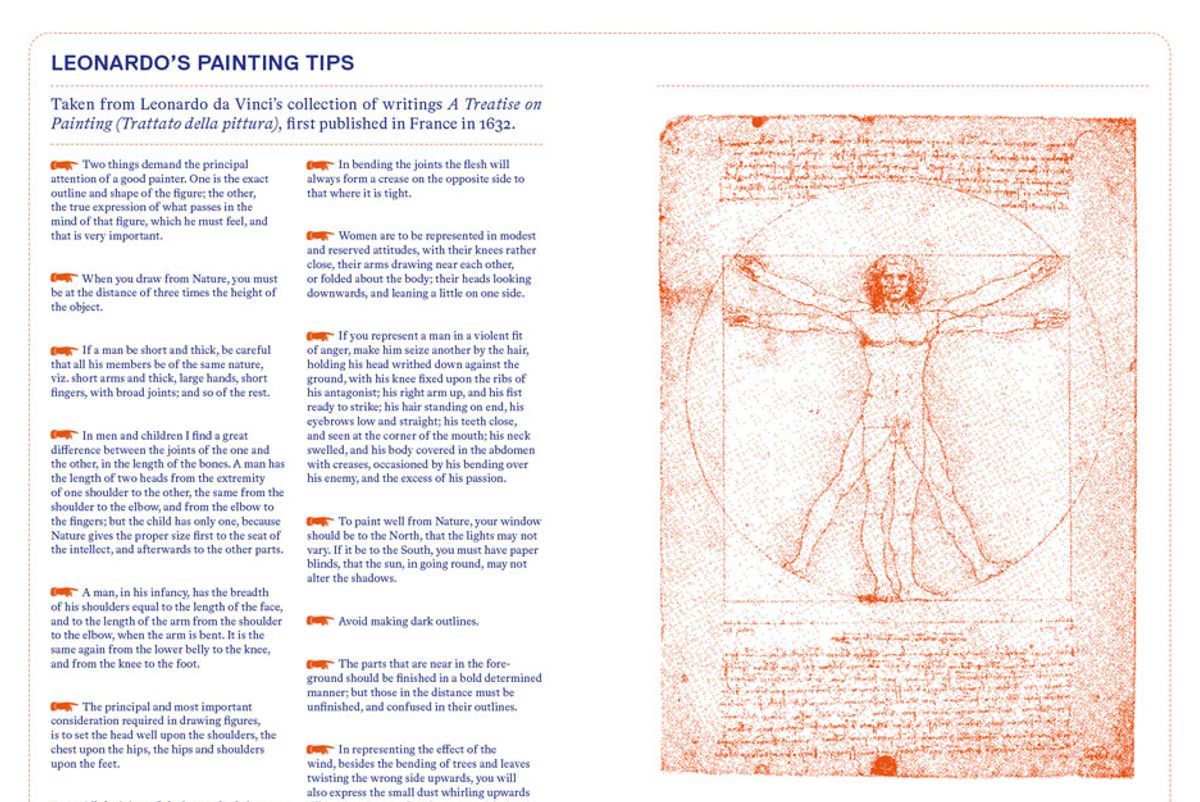What were the names of Henri Matisse’s cats? How many jobs did Agnes Martin have before becoming an artist aged 30? Which French artist collects prosthetic arms and legs? The answers to these questions and other fascinating facts, are all included in Artifacts, a compendium of arty figures and findings presented over five chapters including “Art Studio”, “Art School” and “Art Museum”.
“The publication is a carefully curated selection of hundreds of such miscellaneous yet fascinating findings, each one a pinhole through which we can see a more nuanced view of the world of art ,” say the book editors. Below is an excerpt outlining Leonardo da Vinci’s advice to budding artists (answers to the above: Coussi, Minouche and La Puce; 35 including tennis coach and cherry picker manager; Sophie Calle).
Leonardo’s Painting Tips
Taken from Leonardo da Vinci’s collection of writings A Treatise on Painting (Trattato della pittura), first published in France in 1632.
- Two things demand the principal attention of a good painter. One is the exact outline and shape of the figure; the other, the true expression of what passes in the mind of that figure, which he must feel, and that is very important.
- When you draw from Nature, you must be at the distance of three times the height of the object.
- If a man be short and thick, be careful that all his members be of the same nature, viz. short arms and thick, large hands, short fingers, with broad joints; and so of the rest.
- In men and children I find a great difference between the joints of the one and the other, in the length of the bones. A man has the length of two heads from the extremity
of one shoulder to the other, the same from the shoulder to the elbow, and from the elbow to the fingers; but the child has only one, because Nature gives the proper size first to the seat of the intellect, and afterwards to the other parts. - A man, in his infancy, has the breadth of his shoulders equal to the length of the face, and to the length of the arm from the shoulder to the elbow, when the arm is bent. It is the same again from the lower belly to the knee, and from the knee to the foot.
- The principal and most important consideration required in drawing figures,
is to set the head well upon the shoulders, the chest upon the hips, the hips and shoulders upon the feet. - All the joints of the human body become larger by bending, except that of the leg.
- In bending the joints the flesh will always form a crease on the opposite side to that where it is tight.
- Women are to be represented in modest and reserved attitudes, with their knees rather close, their arms drawing near each other, or folded about the body; their heads looking downwards, and leaning a little on one side.
- If you represent a man in a violent fit of anger, make him seize another by the hair, holding his head writhed down against the ground, with his knee fixed upon the ribs of his antagonist; his right arm up, and his fist ready to strike; his hair standing on end, his eyebrows low and straight; his teeth close, and seen at the corner of the mouth; his neck swelled, and his body covered in the abdomen with creases, occasioned by his bending over his enemy, and the excess of his passion.
- To paint well from Nature, your window should be to the North, that the lights may not vary. If it be to the South, you must have paper blinds, that the sun, in going round, may not alter the shadows.
- Avoid making dark outlines.
- The parts that are near in the foreground should be finished in a bold determined manner; but those in the distance must be unfinished, and confused in their outlines.
- In representing the effect of the wind, besides the bending of trees and leaves twisting the wrong side upwards, you will also express the small dust whirling upwards till it mixes in a confused manner with the air.
• Artifacts: Fascinating Facts about Art, Artists, and the Art World, Sara Bader and Rebecca Morrill (editors), Phaidon, 176pp, £16.95, February (hb)



